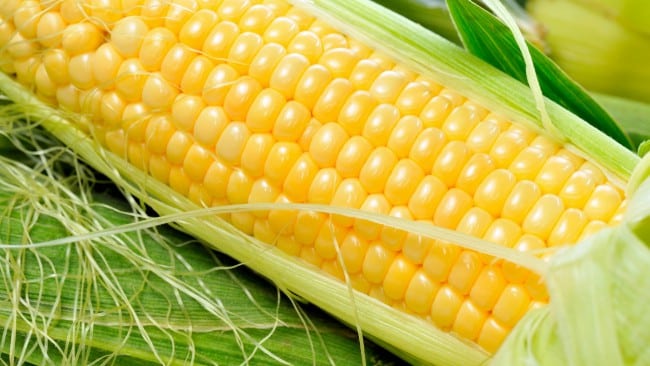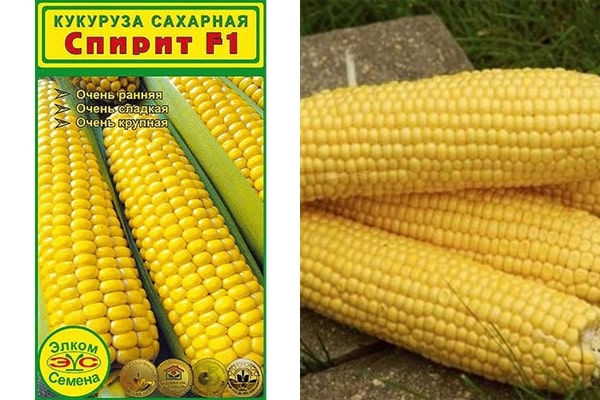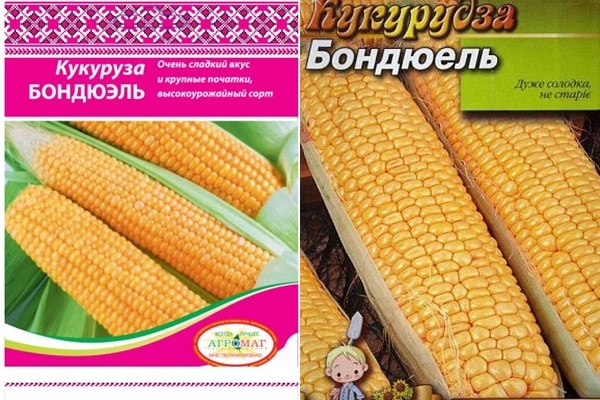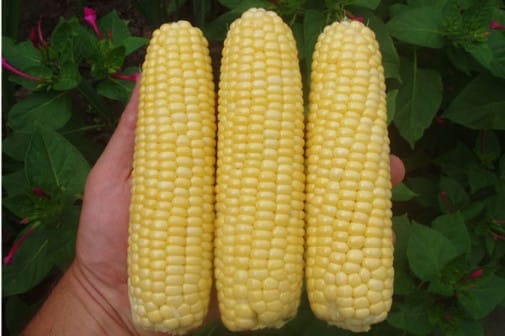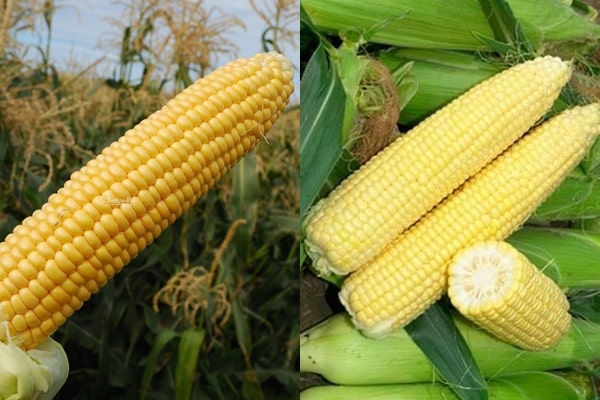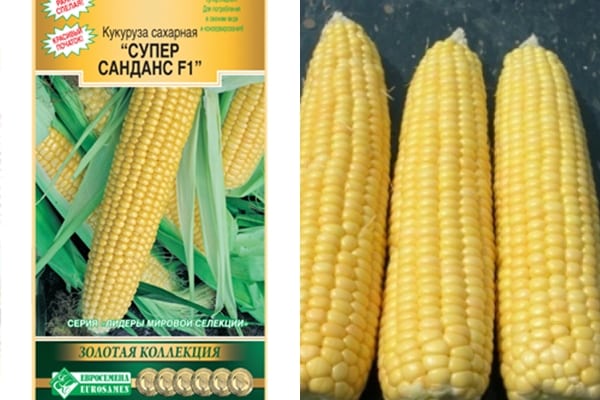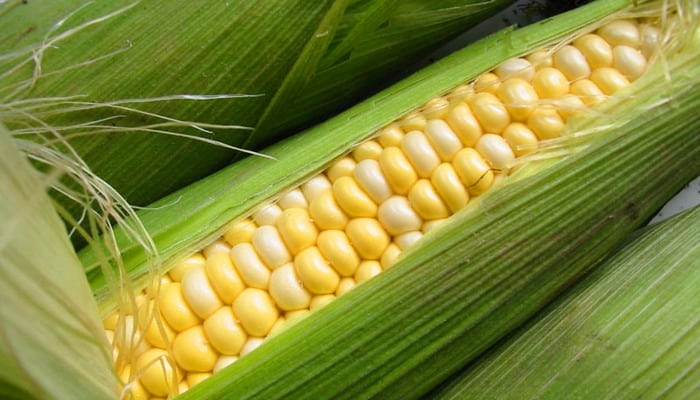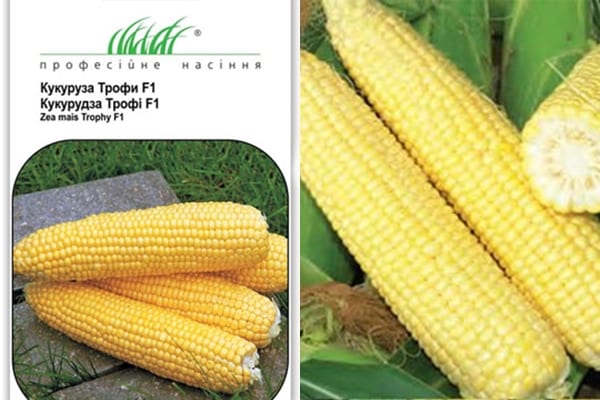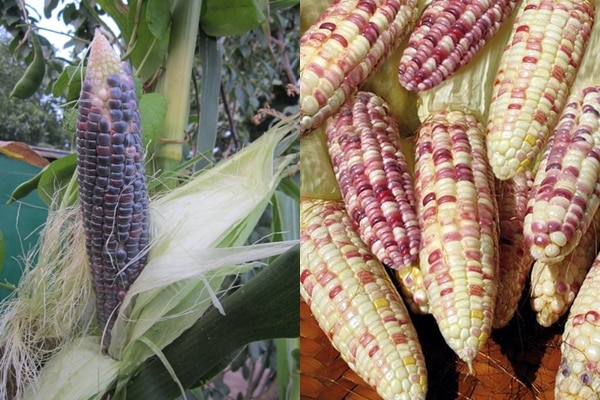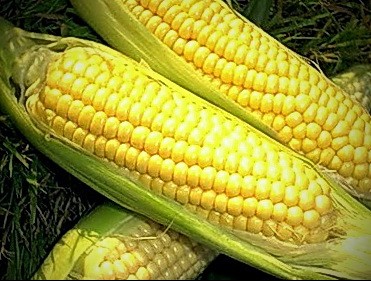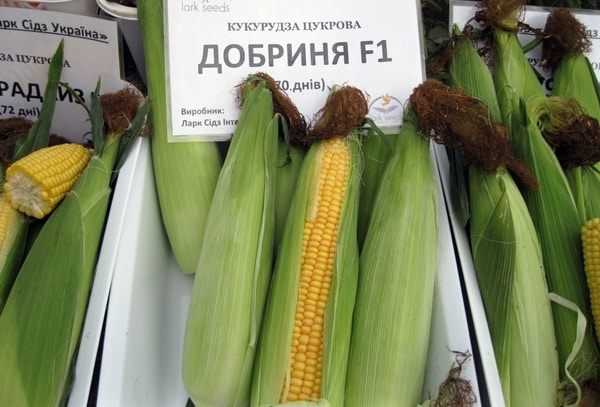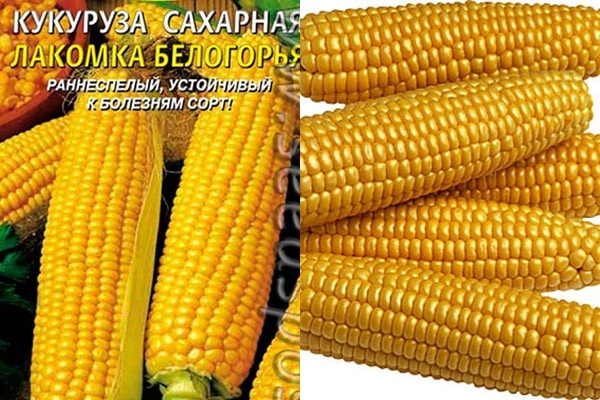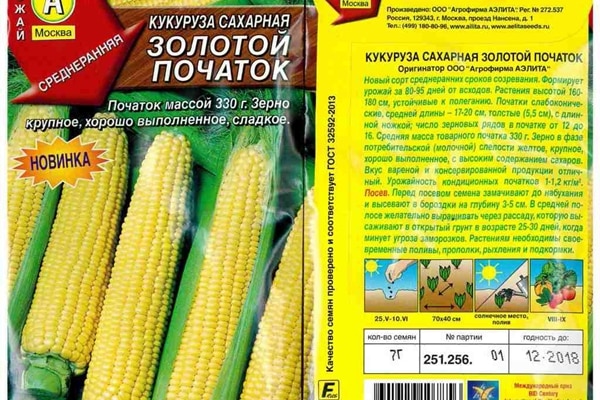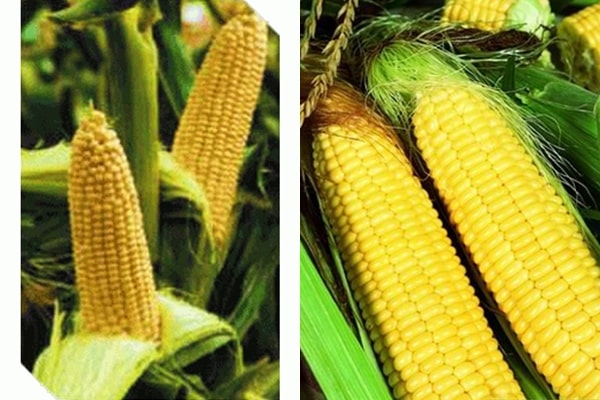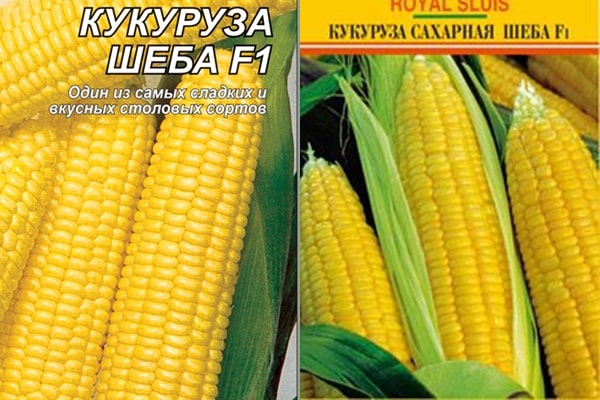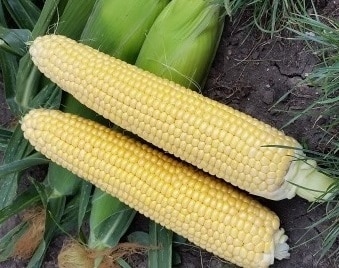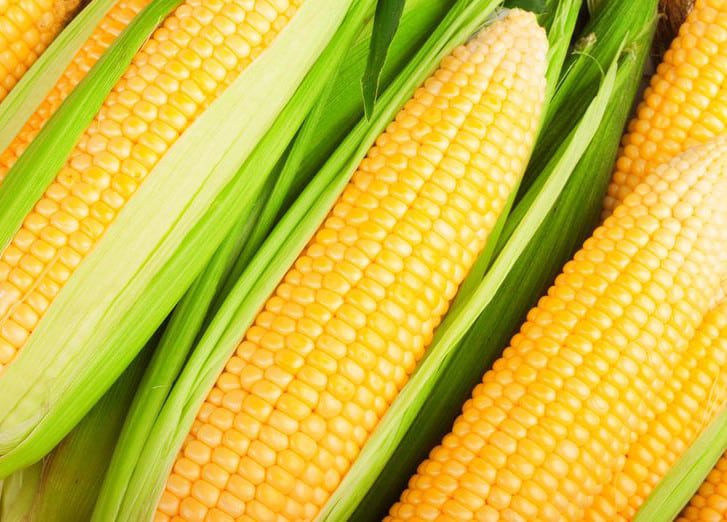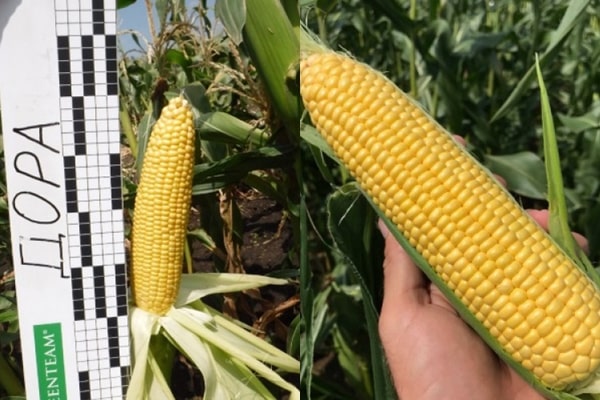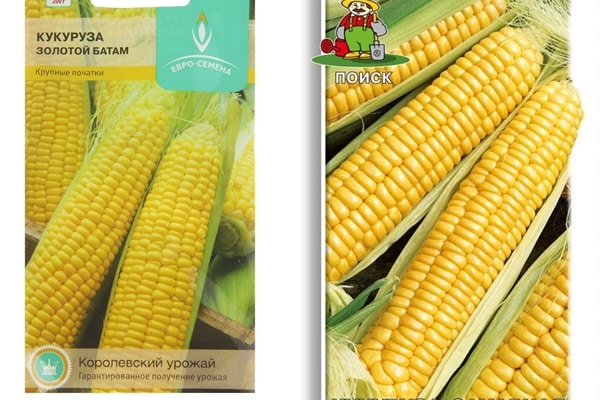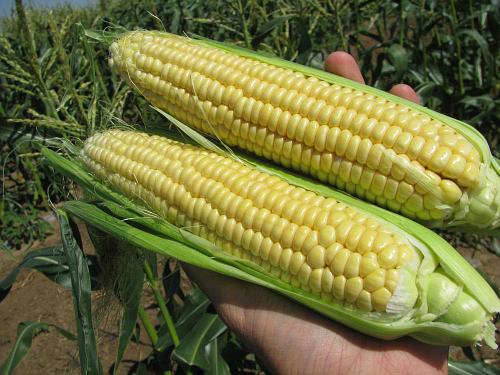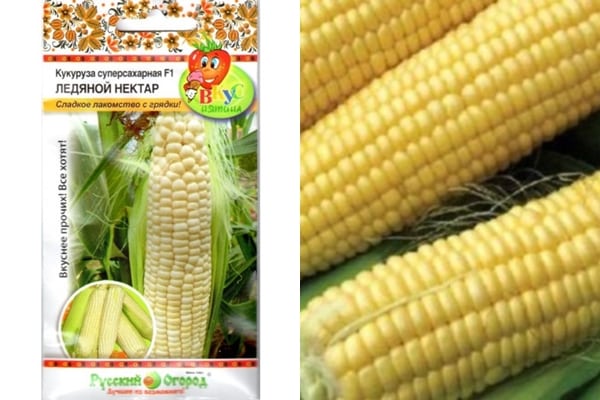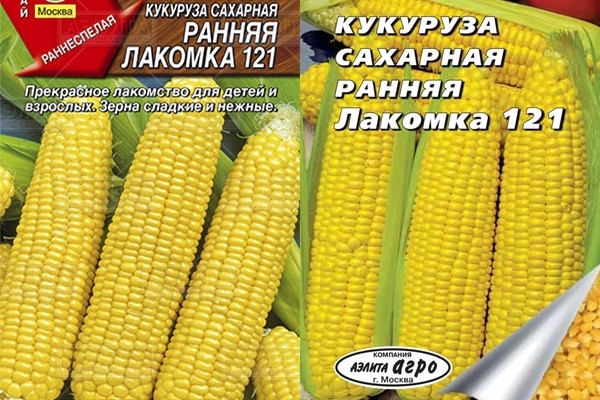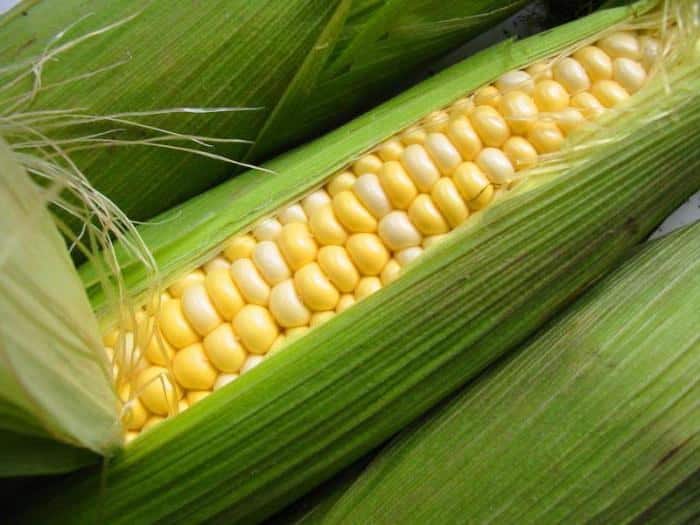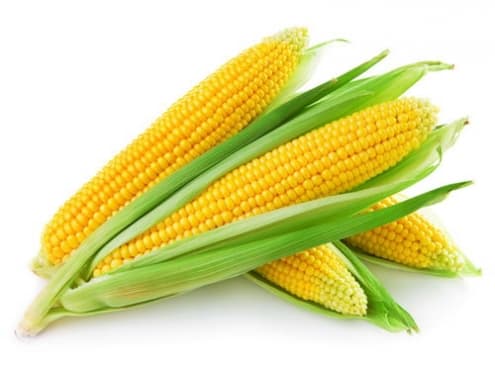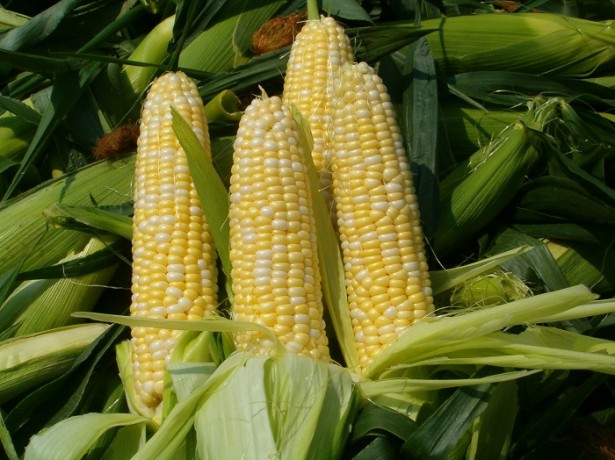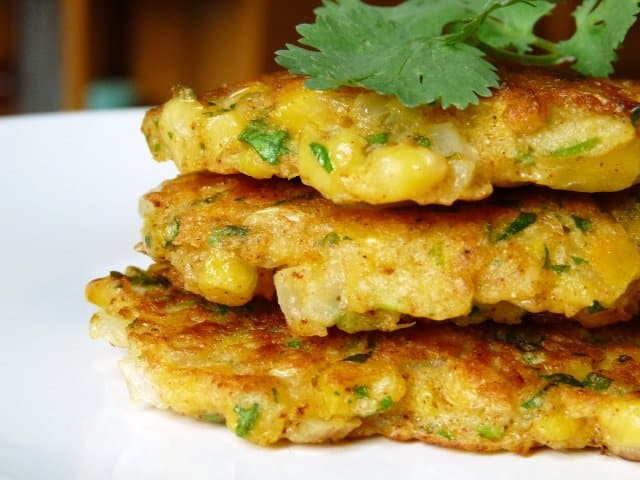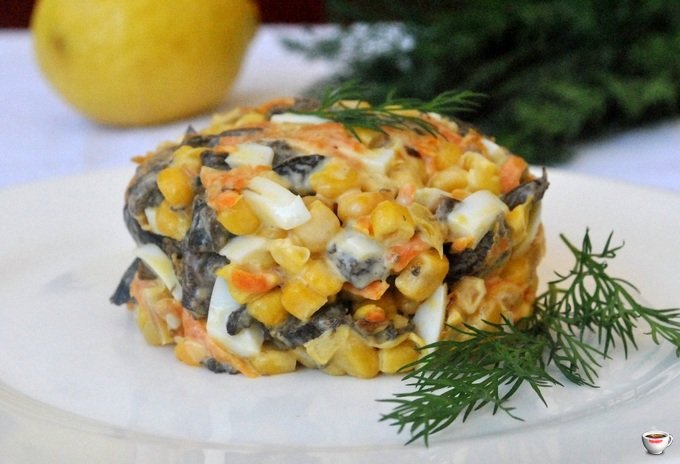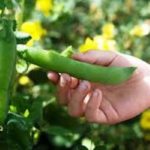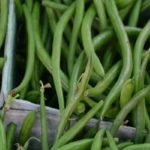The cultivation of sweet varieties and hybrids of corn must comply with certain requirements. The main purpose of the crop is canning. Among the wide variety of the best varieties of sweet corn, you need to choose those that can withstand unfavorable factors, rarely get sick and produce a consistently high yield.
- Biochemical composition of sweet corn seeds
- Popular varieties of sweet corn
- Spirit
- Bonduelle
- Legend F1
- Landmark F1
- Super Sundance
- Dutch
- Trophy
- Black Pearl
- Caramello
- Dobrynya
- Gourmand Belogorya
- golden cob
- Vega F1
- Sheba
- Megaton F1
- Noah
- Dora F1
- Golden Bahtam
- Sweet Nugget
- Ice Nectar
- Early Gourmet
- Features of cultivation
- Landing
- Care
- Harvest
- Delicious dishes with corn Spirit F1
- A simple recipe for cooking corn in a steamer
- Corn fritters
- Corn soup
- Salad with corn and mushrooms
- Corn and pumpkin porridge in a slow cooker
Biochemical composition of sweet corn seeds
Sweet corn is a valuable vegetable crop. Its grains contain a rich vitamin-mineral complex and a high percentage of fats and proteins. At milky-waxy maturity, the grains consist of 3% protein, 20% carbohydrates, 5% fats, 7% sugars and 75% moisture. In addition, the grain contains choline and biotin.
The grains contain many macroelements, microelements, saturated, monounsaturated and polyunsaturated fatty acids. Corn varieties with yellow grains are additionally capable of accumulating vitamin E and carotene. Among all vegetable crops, sweet corn is considered the most high-calorie. There are 880 kcal in 1 kg of corn grains.
Vegetable seeds of sugar varieties are covered with a wrinkled, glassy shell, which indicates a high content of sugar and polysaccharides.
Among sugar vegetable varieties, Spirit is popular. Reviews about the Spirit vegetable variety are only positive. It ripens within two months, the yield is consistently high regardless of the region of cultivation. The ears are long and filled with a large number of large yellow grains.
Popular varieties of sweet corn
Breeders have developed a wide variety of sweet corn varieties. Among them, you can choose the most suitable ones in terms of color, shape, ripening time and care characteristics. The most popular varieties include: Trophy F1, Megaton F1, Boston F1, Overland F1.
The high-yielding corn hybrid Boston F1 is a mid-season plant. The period of maturity begins on the 73rd day.The sweet taste of the grains is suitable for canning and home cooking. Plant height 150 cm. Ear length 19 cm, weight 210 g. The grains are yellow, sugary, yellow in color. The variety is resistant to diseases and lodging.
Dobrynya F1 corn has early ripening and a sweet taste. The plant can grow in any soil and is not afraid of any unfavorable conditions. Therefore, she took one of the first places among vegetable growers.
Spirit corn has good characteristics. The variety is also unpretentious in care, resistant to many diseases and pests, wilting, cold and drought.
Spirit
Spirit corn is grown for canning and can also be eaten fresh. The height of the plant is 190 cm, the length of the cob is 19 cm, the weight is 200 g. The grains ripen on the 65th day, their color is golden yellow.
The variety has good resistance to diseases, especially to helminthosporium, as well as to lodging. The hybrid is characterized by high yield. The sugar content of the grains is more than 12% and contains virtually no starch.
Bonduelle
Bonduelle is a canned food brand that processes sweet corn. Bonduelle corn grains are canned and made into flakes and flour. The most commonly used variety is Spirit or Bonus.
Bonduelle corn is classified as an early-ripening vegetable crop. After the first shoots, the cobs become mature on the 85th day. Plant height is 2.5 meters. The cobs are formed in a classic, cylindrical shape. The length of the cob is 20 cm, weight is 180 g. Large yellow grains are juicy and sweet in taste.
Legend F1
Corn hybrid Legend F1 is one of the most popular among vegetable growers. The variety is distinguished by early ripening of the crop, which can be harvested in 72 days. Stem height 170 cm. Ear length 18 cm.The grains are golden yellow in color, juicy and sweet in taste.
The variety rarely gets sick, especially showing good immunity against head and stem rust, and bacterial rot.
Landmark F1
The very sweet corn variety Landmark F1 is distinguished by its early ripening period - 73 days. Plant height is 200 cm. More than two ears 21 cm long with yellow, large grains can form on the stem.
The main advantage is its high resistance to diseases, especially helminthosporium and smut. The harvested crop is stored for a long time, retaining all its beneficial properties and taste.
Super Sundance
The high-yielding hybrid variety of sweet corn Super Sundance F1 can be canned, boiled or eaten fresh. To get the most sweet and juicy taste, it is better to wait until the milky-waxy stage of maturity.
The plant tolerates drought well, but does not develop well without sufficient lighting. Refers to early ripening crops. From the moment of emergence of seedlings to the onset of maturity, 65 days pass. The length of the cob is 19 cm, weight - 200 g. Super Sundance corn grains are bright yellow in color with a delicate skin.
The variety is resistant to many diseases, including dwarf mosaic. Care requires establishing the correct watering regime and timely application of fertilizers. Seedlings are sensitive to frost.
Dutch
For Dutch corn varieties, choose a sunny place, since the cobs do not form well in the shade. Basic care is no different from cultivating other species. It is imperative to observe sowing dates, take into account crop rotation, apply fertilizers on time, set an irrigation regime, loosen and weed the soil.
Trophy
Trophy F1 corn is grown for further canning, cooking or freezing. In any processing, grains do not lose their nutritional value and beneficial properties. The culture belongs to the early groups and begins to ripen after 75 days. Stem height 20 cm, cob length 21 cm, weight 250 g. The grains are yellow-orange, large and juicy with a thin shell.
The variety is characterized by resistance to diseases, lodging and drought. Seedlings are sensitive to cold. During cultivation, you need to monitor watering and fertilizing.
Black Pearl
Large, juicy grains of corn of the Black Pearl variety are distinguished by their unusual color. When ripe they turn purple-red. The plant is resistant to cold, drought and many diseases.
Caramello
Super early and sweet corn of the Caramello F1 variety will delight you with its ripe harvest after 60 days. The plant reaches a height of 140 cm. The length of the cobs is 21 cm, weight is 250 g. The leaves of the crop are much wider, which allows sugar to accumulate faster and form two full-fledged cobs.
The variety is resistant to lodging. Due to the fact that the root system of the plant is powerful, the variety can tolerate high air temperatures. Suitable for growing in open ground and in greenhouses.
Dobrynya
An early variety of corn is the Dobrynya variety. Harvesting takes place after 70 days. The stem of the plant extends up to 170 cm. The length of the cob is 25 cm. The plant adapts well to any soil and is characterized by resistance to wilting and diseases, especially rust, mosaic, and smut.
Gourmand Belogorya
The early variety of sweet corn Lakomka Belogorya is unpretentious and quickly adapts to any weather conditions. The ripening of the crop occurs on the 82nd day after emergence. Plant height 150 cm.The length of the cobs is 20 cm, their weight is 150 g. The grains are large, golden yellow in color, juicy and sweet in taste.
The crop begins to produce a large harvest early and is highly resistant to disease. The main requirement during cultivation is loosening and fertilizing the soil.
golden cob
Golden Ear corn is easy to care for and results in a sweet and plentiful harvest. Refers to mid-season crops. From the appearance of the first shoots to ripening, 92 days pass. The plant grows up to 170 cm in height. The length of the cobs is 19 cm, weight is 280 g. The grains are large and yellow.
The crop is resistant to lodging, diseases characteristic of grain vegetables and is demanding on loosening the soil, proper watering, timely weeding and fertilizing.
Vega F1
The Vega F1 variety is mid-season corn. The ripening of grains on the cob begins after 75 days. The stem of the plant extends up to 2 meters. The plant is stress-resistant due to its powerful root system, strong stem and wide leaves. The length of the cobs is 24 cm. The harvested crop is stored for a long time.
Sheba
The super early variety of sweet corn is Sheba F1. The plant enters the maturity stage after 68 days. Plant height is 180 cm. The yellow-orange grains can be canned, frozen or eaten fresh. Cob length 22 cm, weight 250 g.
It is resistant to diseases, drought, temperature changes and lodging, and has high yields. Seedlings must be protected from frost.
Megaton F1
The productive corn hybrid Megaton F1 is characterized by a medium-late period of entry into the maturity stage. The harvest can be harvested after 85 days. The height of the plant reaches 250 cm. The root system is powerful, the stem is strong and protects against premature lodging.2-3 ears can form on one stem. The length of the cob can reach 30 cm.
The grains have a rich yellow color. The crop tolerates drought, rarely gets sick and is subject to attack by pests. The harvested crop is stored for a long time, maintaining its juiciness and sweetness.
Noah
Dutch breeders have developed a super-sweet corn variety, Noah F1; descriptions and reviews will help you make your choice. The harvested crop is suitable for canning and cooking. The length of the cob is 20 cm, weight 450 g, the grains are large, bright yellow.
The plant is tall, 210 cm. Harvest ripening time is short, only 70 days. Noah corn is rarely exposed to disease, rarely suffers from helminthosporium and bacterial rot.
Dora F1
Dora F1 sweet corn is valued for its excellent taste and ease of care. Refers to early ripening varieties, ripening dates begin on the 65th day from the appearance of the first shoots. The plant is powerful, 170 cm high. The length of the cobs is 22 cm. The grains are golden yellow.
The harvested crop retains its sweetness and juiciness for a long time, without a starchy aftertaste. The vegetable crop is resistant to diseases, especially helminthosporium.
Golden Bahtam
The mid-early corn variety Golden Batam allows you to harvest mature ears after 75 days. The stem of the plant stretches up to 170 cm. The length of the cob is 19 cm, weight is 200 g. The grains are sweet, yellow in color.
The advantages of the variety are stable yield and high sugar content. Harvesting begins at the milk maturity stage. During the season, it is necessary to carry out at least three loosenings, regular watering should be established, and fertilization should be carried out three times. If necessary, insect and disease repellents can be used.
Sweet Nugget
Hybrid supersweet corn varieties include Sweet Nugget F1. In a short time, a rich and high-quality harvest is formed. The growing season lasts 72 days. The plant reaches a height of 170 cm. 2–3 ears of 23 cm in length are formed on the stem. The grains are yellow and medium in size. The leaves are wide and dark green in color, which allows you to store more sugar.
A distinctive feature is resistance to diseases, various viruses and rot. Cobs collected in the milk stage are stored for a long time, maintaining their hardness and excellent taste.
Ice Nectar
Ice Nectar corn is classified as a late-bearing crop. From the moment of emergence of seedlings to the formation of mature grains, 130 days pass. The plant stretches up to 180 cm. The length of the cobs can reach 25 cm. The grains are large and juicy, of an unusual white-cream color.
Early Gourmet
High-yielding corn variety Early Gourmet 121 has only positive reviews from vegetable growers. A friendly harvest is formed after 70 days. The plant is of medium height, 145 cm. The cylindrical cob is 21 cm long, weighs 190 g. The grains are yellow, juicy, large with a thin and delicate skin.
The plant is characterized by high resistance to diseases. It is advisable to grow early gourmet corn through seedlings. Vegetable crops require timely watering, fertilizing, weeding and loosening.
Features of cultivation
The technology for growing sweet corn after planting has its own characteristics.
If the summer is short, then it is best to plant through seedlings. Corn seeds sow in separate cups to a depth of 3 cm, sprinkling sand on top. In the future, moderate watering and air temperature of +20 degrees are recommended.A week before transplanting, fertilize and sprinkle with sand to prevent crust formation.
Sowing seeds in open ground is carried out in mid-May. The scheme for early varieties looks like this: 60x30 cm, for late varieties - 70x70 cm. The prepared holes are spilled with water, three grains are placed in them, then covered with wet and dry soil.
Landing
Corn is considered a light-loving crop. You need to choose a sunny area, away from the shade of trees and fences, preferably on the south side of the house. In this case, the site must be protected from through winds.
The best predecessors for corn legumes, potatoes, cucumbers, tomatoes, onions, and fodder beets are considered. Corn should not be sown after millet and cabbage.
Corn does not have any special requirements for soil composition, but podzolic, peat and chernozem soil is best suited. The vegetable crop does not tolerate low-lying soils with poor water drainage.
In the fall, during land preparation, it is advisable to apply organic and phosphorus-potassium fertilizers. In the spring, they loosen the soil and walk through the area with a rake, breaking up large clods of earth.
Corn seeds of the Spirit variety or any other type are sorted before planting, only healthy and dense ones are selected, soaked in growth stimulants and disinfected. It is advisable to warm the seeds in the sun for 5 days, then soak them in hot water. This procedure will speed up seed germination.
Corn is sown in mid-May, when the threat of frost is behind us. By this time the soil should warm up to +10 degrees. The day before planting the seeds, you can apply nitrogen fertilizers. Before planting, the soil must still be loosened to a depth of 10 cm.
They begin to sow corn in open ground at the end of April or early May.The first shoots should appear on days 10–12. In the prepared area, furrows are made to a depth of 7 cm. If the area is small, then rows are made at a distance of 60 cm.
Grain crops for seedlings begin to be sown in early May; it is best to plant the seeds in separate peat pots. In this case, there will be minimal risk of damaging the root system during transplantation. Already in mid-June, they begin to transplant seedlings into open ground. By this time, three true leaves should appear on the seedlings.
Care
During the entire period of growing sweet corn, you need to follow some recommendations. The first time after planting the plant grows slowly. At this time, loosening and weeding will benefit him. Rules of agricultural technology:
- Corn requires abundant watering. The size of the cobs and the sweetness of the grains directly depend on the correct watering regime. Particularly a lot of moisture is required during seed germination and cob formation.
- Loosening the soil is carried out after each watering and after rain. The higher the plant becomes, the shallower the soil loosening depth. This will reduce the risk of damage to adventitious roots.
- During the flowering period, an additional pollination procedure can be carried out. To do this, they pick off the male flowers (they are located at the top of the stem) and shake them over the flowering ears (the female flowers are located here).
- To speed up the growth of the plant and the formation of the cob, pinching is carried out. All side shoots are trimmed.
- Weeds should not be allowed to grow, so timely weeding is carried out.
- Carry out preventive treatments to protect against pests and diseases. At the first signs of their appearance, measures must be taken to preserve the harvest.
A special place is occupied by the application of fertilizers. Corn responds well to compost and humus.The first fertilizing can be done when the plant has 5-6 leaves. After the fifth leaf unfolds, potassium fertilizers are applied. A liquid solution of ammonium nitrate and superphosphate can be added to the row spacing.
If the leaves become pale green and have yellow veins, it may be necessary to add nitrogen components. If the edges of the leaves begin to turn yellow and dry, you need to add potassium.
Harvest
The cobs are suitable for harvesting at the stage of milky-wax maturity. It is important not to skip this period, otherwise the grains will become rough, hard and lose their juiciness. There are several signs that determine the ripeness of corn:
- You can determine the ripeness of the cob by looking at the corn silk. It turns from emerald green to yellow-brown.
- Another sign of ripeness is the color of the grains. They are painted white or yellow depending on the variety chosen. In this case, the grains fit tightly to each other, and the shell is easily pierced.
- The outer wrapping leaves of the head of cabbage become dry and begin to turn yellow.
More often corn harvest They begin to collect in early August. It is best to harvest early in the morning.
Judging by the reviews, Lakomka Belogorye corn won one of the first places among experienced vegetable growers. It is noted that corn plantings are easy to care for during cultivation; almost all sown seeds germinate promptly and on time. The first cobs can be eaten after 90 days.
On one stem, 150 cm high, up to 4 ears can form. Vegetable growers also note the high yield of the variety; the plant does not require frequent watering; the grains of the collected cobs retain their juiciness and sweetness for a long time.
Delicious dishes with corn Spirit F1
There is a wide variety of recipes where sweet corn of any variety can be used, including Spirit F1.
A simple recipe for cooking corn in a steamer
The cobs are cleared of leaves, washed with cool water and dried with a towel. Water is poured into the bowl, and the cobs themselves are placed for steaming. Close the lid and set the time to 35 minutes. After the finished corn has cooled, the cobs are greased with butter, sprinkled with salt and served.
Corn fritters
To prepare, you will need cornmeal and canned sweet corn. Drain water from canned grains. Add kefir to a separate bowl, dilute flour in it, add salt, sugar and soda. All ingredients are thoroughly mixed. Add canned corn kernels to the resulting dough and begin frying. Use a spoon to measure out a small portion of the dough and place it in the pan.
Corn soup
Finely chop the peeled onions, chop the peeled carrots and celery using a grater. Potatoes and zucchini are cut into small cubes.
Melt butter (20 g) and vegetable oil (25 ml) in a saucepan, and then add chopped onion, frying until golden brown. After this, add carrots and celery, and after a couple of minutes, potatoes. Vegetables are poured with a liter of boiled water.
5 minutes after boiling, add zucchini and canned corn to the vegetables along with the liquid in the jar. After this, cook for another 10 minutes. At the end of cooking, add salt, spices and grated processed cheese.
It is recommended to grind the finished soup in a blender until smooth. The finished dish can be decorated with herbs.
Salad with corn and mushrooms
Boil chicken fillet in salted water.The champignons are washed and cut into small cubes. Fry the chopped onion in heated vegetable oil until golden brown, then add the mushroom cubes. After 15 minutes of frying, add salt and pepper to the onions and champignons.
The hard cheese is grated, the water is drained from the canned corn, the chicken fillet is removed from the broth and allowed to cool. After this, the fillet and canned pineapple are cut into small cubes.
Then they begin to form the salad. The first layer in the salad bowl is chicken, then onions and mushrooms. Place corn and chopped pineapple on the mushrooms and cover everything with mayonnaise. Top everything evenly with cheese.
Corn and pumpkin porridge in a slow cooker
The peeled pumpkin pulp is cut into cubes and placed in a multicooker bowl. Add water and simmer for 30 minutes. At this time, the corn grits are washed. As soon as the pumpkin is ready, add milk, salt, sugar, corn grits and simmer again for 30 minutes. After this, add butter and heat for 10 minutes. The porridge is ready.

